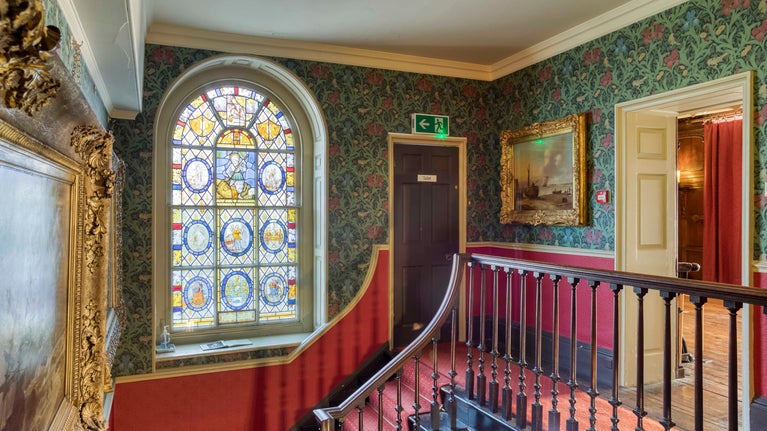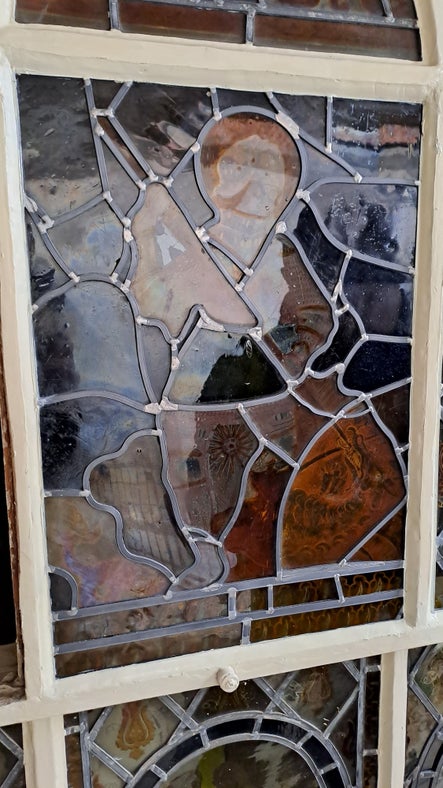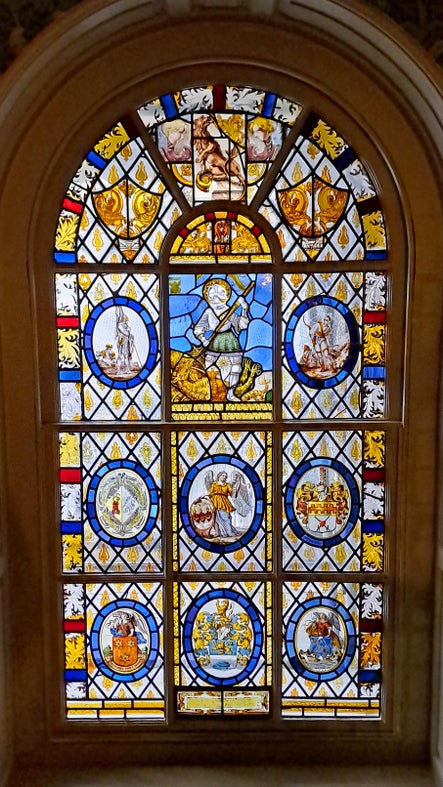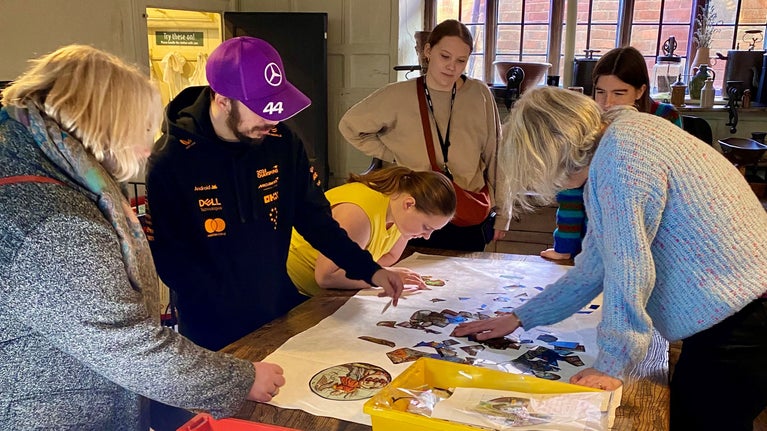Rare ancient stained-glass panels conserved and on display at Elizabethan House Museum
- Published:
- 31 March 2025

A four-month conservation project to care for and protect a rare historic stained-glass window at the Elizabethan House Museum in Great Yarmouth has been completed.
The project has been a collaborative effort between the National Trust, who own the building, and Norfolk Museums Service, who manage and open the building to visitors, along with specialist conservators from Holy Well Glass.
The stained-glass window features thirteen stained-glass sections, including panels with 16th and 17th century European glass, from the Low Countries and some that originated in the cloister of the Premonstratensian Abbey of Steinfeld in the Eifel region of Germany. Another section has an English panel from the 15th century depicting St. George and the Dragon.
The window is set in a timber frame, probably dating to the late 19th or early 20th century. It was re-glazed as part of a full, documented restoration project in 1952. However, the 70-year-old leadwork was failing, leading to severe bowing in areas.
Megan Dennis, Property Curator for the National Trust’s Blickling Estate and Elizabethan House Museum, said: “Windows with a mix of foreign and local ancient glass set in later surrounds were once common in this area, but now only a few exist. The Elizabethan House Museum in Great Yarmouth is the only known example, open for people to visit, and we are really pleased that its future has been secured with the work carried out, enabling many more people to see it.”
National Trust Conservator, Martha Infray, explained what was involved in the conservation project: “It was quite a challenge to remove the seven stained-glass panels from the Elizabethan House Museum, requiring both internal and external scaffolding to gain safe access.
“At the specialist glass conservation studio, Holy Well Glass in Somerset, the panels were assessed to determine which areas of leadwork could be retained. Glass was then partially dismantled from the lead. Each piece of glass was carefully cleaned using a mixture of acetone and de-ionised water on cotton buds and soft sable brushes. Leaded light cement and historic silicone were then removed and glass with clean breaks were re-aligned and bonded.”
Two jewels in the panel featuring St. George and the Dragon were loose and have been re-fixed, and panels were then re-leaded and soldered, as part of the project.

Conserved glass panel viewed from the outside at the Elizabethan House, Great Yarmouth | © Martha Infray 
The stained glass window at the Elizabethan House window after conservation | © Martha Infray
When Holy Well Glass returned to the Elizabethan House Museum last month to reinstate the conserved panels, they also installed an Environmental Protective Glazing (EPG) system to the outside of the window to protect the delicate glass panels from wind-flex and damaging cycles of condensation.
With changing climate patterns predicted to include more wet and windy weather, the new EPG allows the window to be properly ventilated, reducing the risk of corrosion and deterioration, extending the lifespan of the stained-glass panels without impacting its appearance.

Installing the Environmental Protective Glazing at Elizabethan House | © Martha Infray 
The new Environmental Protective Glazing at the Elizabethan House | © Martha Infray
A key part of the conservation project involved engaging the local community, and four workshops, led by local artist Rose Feather, were held with young people over a series of days in February, including groups from the YMCA and the National Saturday Art Club.
Those involved worked to create responses to the stained-glass window conservation project, which will be on display at the Elizabethan House Museum throughout the year.
Johanna Jones, Curator at Norfolk Museums Service said: “We are delighted to see the return of the stunning stained glass at the museum, as the centrepiece in the staircase after its conservation work. Not only has this project restored and conserved this historic window for perpetuity but it has also enabled us to transform how we plan to interpret the histories of the building for our younger audiences.
“Running alongside the conservation work, we have worked with youth groups and artists to interrogate the many examples of stained glass around the museum to reimagine and create new interventions and trails about stained glass for our audiences as part of our main displays.”
Katherine Sarginson of Norfolk Museums Service added: “It has been wonderful to work with the National Trust, Rose Feather and the Kick the Dust groups on this project. Seeing the groups get so excited about the conservation and design of stained-glass windows has been really inspiring and has shown how important projects like this are for learning about the history of Great Yarmouth.
“The young people who have worked with us are all so creatively talented and this has led to such wonderful designs which will be on display from mid-April".

The stained-glass conservation work was funded by the National Trust’s Remedial Conservation Fund, which includes donations and legacies from members and supporters. To find out more about how you can support the National Trust, visit www.nationaltrust.org.uk/support-us
The Elizabethan House Museum is open to visitors from Monday 31 March until Friday 31 October, 10am-4pm, Sunday to Friday (closed Saturdays).



